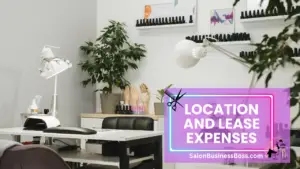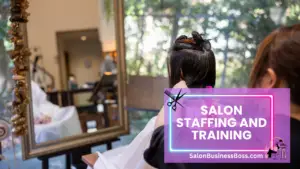Launching a salon can be an exciting venture, offering opportunities for creativity and entrepreneurship. However, it is essential to recognize that starting a salon requires a significant initial investment.
A salon start-up costs can range from $10,000-$90,000, covering expenses like location lease, infrastructure, equipment, staffing, marketing, inventory, insurance, and more. A well-prepared budget is vital for a successful venture.
1. Location and Lease Expenses:
The location of a salo n is undeniably one of the most critical factors that can determine its success. Choosing the right location can significantly impact the number of customers your salon attracts and its overall profitability. High foot traffic areas or trendy neighborhoods are often prime spots for salons as they provide greater visibility and accessibility to potential clients. However, such locations come with a higher price tag, requiring careful consideration of your budget and financial capacity.
n is undeniably one of the most critical factors that can determine its success. Choosing the right location can significantly impact the number of customers your salon attracts and its overall profitability. High foot traffic areas or trendy neighborhoods are often prime spots for salons as they provide greater visibility and accessibility to potential clients. However, such locations come with a higher price tag, requiring careful consideration of your budget and financial capacity.
Leasing costs can vary dramatically based on the city or town you select for your salon. Urban areas or popular commercial districts usually command higher rent prices due to increased demand. On the other hand, smaller towns or less sought-after locations may offer more affordable leasing options. For a moderate-sized salon, lease expenses typically range from $2,000 to $5,000 per month, and this figure includes the initial security deposit required by most landlords.
While it may be tempting to cut costs by choosing a less expensive location, it’s crucial to strike a balance between affordability and potential customer reach. Investing in a well-located salon can pay off in the long run as it can attract more walk-in clients and create a positive impression on potential customers. Proper market research and understanding your target audience can help you identify the best location that aligns with your business goals and budget, ensuring a promising start for your salon venture.
Read more about: The Cost of Beauty: Hair Salon Start-Up Expenses
2. Salon Infrastructure and Design:
The ambiance of a salon plays a crucial role in shaping the overall customer experience and, ultimately, its success. A welcoming and stylish environment can create a positive and lasting impression on clients, encouraging them to return and recommend the salon to others. When it comes to creating such an ambiance, the salon’s infrastructure and design are fundamental considerations.
Salon infrastructure and design expenses encompass a wide array of elements that contribute to the overall aesthetics and functionality of the space. Interior decoration, including wall colors, artwork, and decorative accents, can set the tone and create a specific atmosphere that aligns with the salon’s branding and target clientele. Furniture and fixtures should be carefully chosen to balance comfort, practicality, and style.
Effective lighting is paramount in a salon, as it can enhance the appearance of clients and the work of stylists. Properly lit mirrors and stations ensure that customers can see the results of the services clearly. Flooring choices should be durable, easy to maintain, and aesthetically pleasing.
While high-end decor and premium materials can elevate the salon’s image, they also come with substantial costs. For those with budget constraints, a mid-range setup can still achieve a stylish ambiance without breaking the bank. With a budget of around $5,000 to $15,000, salon owners can invest in well-designed and reasonably priced decor and furnishings that complement the salon’s theme and cater to clients’ comfort.
Creating a welcoming and stylish ambiance is an investment that pays dividends in customer satisfaction, loyalty, and positive word-of-mouth referrals. By striking the right balance between cost and aesthetics, salon owners can ensure their space is an inviting and memorable destination for clients seeking a rejuvenating and pleasurable salon experience.
3. Salon Equipment and Supplies:
To ensure the delivery of top-notch services, investing in high-quality salon equipment and supplies is essential for any aspiring salon owner. Basic salon equipment forms the backbone of salon operations, including stylish and comfortable styling chairs, wash basins with modern fixtures, efficient hairdryers, and versatile beauty trolleys. These essential pieces collectively contribute to the comfort and convenience of both customers and salon staff. However, the initial investment for such equipment can range from $5,000 to $10,000, depending on the brand and quality chosen.
Beyond equipment, salon owners must also consider the ongoing monthly expenses for salon supplies. These include a wide variety of haircare products such as shampoos, conditioners, hair dyes, and styling products. Estimating and factoring these recurring costs into the budget is vital to ensure smooth operations and to maintain a diverse range of options for clients.
Ultimately, investing in high-quality salon equipment and supplies not only enhances the customer experience but also reflects the salon’s commitment to professionalism and excellence. By providing clients with the latest tools and top-of-the-line products, the salon can build a strong reputation and attract a loyal clientele.
4. Licensing and Permits:
Opening and operating a salon involves compliance with various regulations and licensing requirements. These essential expenses include obtaining business permits, health and safety certifications, and specific licenses for the salon’s services. The exact costs of obtaining these licenses can vary significantly based on the salon’s location and the types of services offered.
In many areas, a general business license is required to legally operate any commercial establishment. Additionally, salon owners must adhere to health and safety standards to ensure a safe environment for both customers and staff. Depending on local regulations, specialized salon-specific licenses may be necessary for certain services such as nail care, beauty treatments, or hair extensions.
The cost of licensing and permits can range from $500 to $2,000, depending on the complexity and number of licenses required. It is crucial for salon owners to conduct thorough research on their local government’s regulations and licensing requirements to avoid any legal issues and ensure the smooth operation of their salon. Complying with these requirements not only keeps the salon within the law but also builds trust with customers, assuring them of a professional and reputable establishment.
5. Salon Staffing and Training:

The success of a salon hinges on the skills and dedication of its staff. Hiring and retaining a team of skilled professionals are paramount for delivering exceptional services and fostering a loyal clientele. Employee expenses encompass not only salaries but also benefits and training costs.
Hiring experienced staff may command higher initial salaries, but their expertise can bring immediate value to the salon. On the other hand, investing in training for new talents can be a wise long-term strategy, as it ensures a consistent level of service quality and allows the salon to nurture a team aligned with its vision and values.
Salon owners should anticipate spending around $15,000 to $30,000 on staff-related expenses in the first few months. This budget includes salaries, taxes, insurance, and training programs. While staffing costs constitute a significant part of the budget, the investment pays off by providing customers with an elevated experience, leading to increased customer satisfaction and loyalty.
By fostering a positive and supportive work environment, offering competitive compensation, and providing opportunities for growth and development, salon owners can attract and retain talented staff, elevating the salon’s reputation and ultimately contributing to its long-term success.
Read more about: Tanning Salon Business Profit: Financial Insights
6. Marketing and Advertising:
In the competitive world of salons, effective marketing and advertising are essential to stand out from the crowd and attract a steady stream of clients. A well-thought-out marketing strategy can help build brand awareness and establish a positive reputation within the local community.
The costs for marketing and advertising efforts can vary depending on the scope and reach of the campaigns. Digital marketing, including social media promotions, email campaigns, and search engine optimization, is a cost-effective way to target potential clients online. Budgeting around $2,000 to $7,000 for digital marketing efforts allows the salon to reach a broader audience and engage with potential clients in real-time.
Traditional advertising methods, such as flyers, print advertisements, and direct mail, may also be incorporated into the marketing budget, depending on the salon’s target audience and the local market.
Investing in marketing and advertising not only attracts new clients but also fosters client loyalty by showcasing the salon’s services and expertise. Creating a consistent and appealing brand message across all marketing channels helps the salon establish a recognizable identity and fosters a positive reputation, ultimately contributing to its growth and success in the competitive beauty industry.
7. Inventory Management:
Efficient inventory management is crucial for the smooth functioning of a salon. Properly managing haircare products, beauty supplies, and retail items ensures that the salon always has the necessary stock to meet customer demands without overstocking or wastage. Maintaining a well-organized and up-to-date inventory system saves time and money and enhances customer satisfaction.
Estimating the initial inventory costs can be challenging, as it depends on the size of the salon, the range of services offered, and the brands and products chosen. A reasonable approach would be to allocate between $3,000 to $8,000 for stocking up on the necessary products. This budget should include a variety of shampoos, conditioners, hair dyes, styling products, beauty treatments, and retail items.
To optimize inventory management, salon owners should invest in a digital inventory tracking system. This system helps monitor stock levels, reorder products when necessary, and identify popular products that need to be restocked more frequently. By minimizing stockouts and wastage, the salon can improve profitability and ensure clients have access to their favorite products consistently.
Regularly auditing the inventory, tracking product performance, and negotiating deals with suppliers are essential strategies to maintain a balanced inventory and reduce carrying costs. A well-managed inventory ensures that the salon can operate efficiently, provide excellent customer service, and remain competitive in the market.
8. Software and Point-of-Sale (POS) Systems:
In today’s tech-driven world, investing in salon management software and a reliable POS system is a prudent decision for any modern salon owner. These tech solutions streamline various aspects of salon operations, leading to improved efficiency and better customer experiences.
A reliable salon management software offers features such as appointment booking, staff scheduling, and client management. This streamlines the booking process, reduces scheduling conflicts, and helps maintain organized client records. The initial cost of acquiring salon management software can range from $1,000 to $5,000, depending on the complexity and features of the chosen system.
Integrating a POS system into the salon’s operations simplifies payment processing and inventory tracking. It allows for seamless transactions, inventory updates, and real-time sales reports. A POS system typically costs between $1,000 to $2,500, depending on the hardware and software specifications.
9. Insurance and Legal Expenses:

Protecting a salon from potential liabilities is a fundamental aspect of responsible business management. Salon owners should invest in comprehensive insurance coverage tailored to their specific needs. The cost of insurance can vary depending on factors such as the size of the salon, the range of services offered, and the location.
Insurance coverage for a salon typically includes general liability insurance, which protects against property damage and bodily injury claims. Professional liability insurance, also known as malpractice insurance, is essential for salons offering specialized services like hair treatments or chemical procedures. Additionally, salon owners may consider business property insurance to safeguard against theft, fire, or other property-related risks.
The cost of insurance coverage may range from a few hundred to a few thousand dollars annually, depending on the level of coverage and the insurance provider. It is crucial for salon owners to shop around for quotes and understand the terms and conditions of each policy before making a decision.
Legal expenses are another essential consideration for salon start-ups. This includes costs associated with business registration, permits, and contracts with suppliers and staff. Legal fees can range from $2,000 to $5,000, depending on the complexity of legal requirements and the need for professional legal advice.
Read more about: Salon Business Expenses: Key Cost Components
10. Unexpected Contingencies:
In the unpredictable world of business, planning for unexpected contingencies is a smart financial move. Every salon start-up should allocate a contingency budget to handle unforeseen challenges or emergencies that may arise during operations.
Contingency funds act as a safety net, allowing salon owners to navigate unexpected circumstances without jeopardizing the business’s financial stability. Allocating about 5% to 10% of the total budget for contingencies is a prudent approach. For a salon with a budget ranging from $10,000 to $90,000, this means setting aside approximately $500 to $9,000.
Potential unforeseen circumstances may include sudden equipment breakdowns, unexpected repair costs, temporary business closures due to unforeseen events, or fluctuations in cash flow. Having a contingency fund ensures that the salon can handle these situations with resilience and continue providing services to clients without interruption.
Salon owners should prioritize building and maintaining a contingency fund from the early stages of planning their salon start-up. A well-prepared contingency budget demonstrates financial prudence and responsible management, increasing the chances of long-term success for the salon venture.
Conclusion
Starting a salon demands careful financial planning and a comprehensive understanding of the expenses involved. The total costs for launching a salon can range from $10,000 to $90,000, depending on various factors. By meticulously budgeting and accounting for each category of expenses, aspiring salon owners can set a strong foundation for their business and focus on delivering exceptional services to their clientele. Remember, every successful salon begins with a well-prepared and realistic financial strategy.
Frequently Asked Questions

1. What should I consider when managing salon inventory?
Allocate around $3,000 to $8,000 for stocking up on salon products, including haircare items, beauty supplies, and retail products.
2. Do I need salon management software and POS systems?
Investing in reliable salon management software and POS systems can enhance efficiency and should be budgeted between $1,000 to $5,000.
3. What expenses should I expect for insurance and legal matters?
Insurance coverage costs vary based on salon size and chosen coverage types, while legal expenses for business registration and contracts could amount to $2,000 to $5,000.
To learn more on how to start you own salon checkout my startup documents here.
Please note that the contents of this blog are for informational and entertainment purposes only and should not be construed as legal advice. Any action taken based on the information provided in this blog is solely at your own risk. Additionally, all images used in this blog are generated under the CC0 license of Creative Commons, which means they are free to use for any purpose without attribution.

About the author. Entrepreneur and Salon Business Fan.
Hi! I am Shawn and I am a happy individual who happens to be an entrepreneur. I have owned several types of businesses in my life from a coffee shop to an import and export business to an online review business plus a few more and now I create online salon business resources for those interested in starting new ventures. It’s demanding work but I love it. I do it for those passionate about their business and their goals. That’s why when I meet a salon business owner, I see myself. I know how hard the struggle is to retain clients, find good employees and keep the business growing all while trying to stay competitive.
That’s why I created Salon Business Boss: I want to help salon business owners like you build a thriving business that brings you endless joy and supports your ideal lifestyle.

